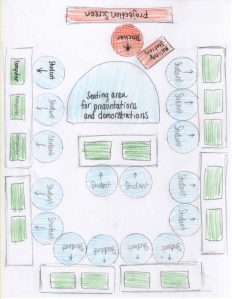Principle H3: Community & Classroom as a Milieu for Learning
The HOPE principle H3 requires that teachers honor the classroom/school community as a milieu for learning. To me this means teachers are to utilize the environment of a classroom, within the community of school, in a way that helps creates a physical and inclusive social setting conducive to learning. As far as the physical space, teachers can follow the basics outlined by Marzano, Marzano & Pickering (2003), such as ensuring students can easily see the teacher and front of the room, frequently used materials are accessible, pathways are clear, students can easily be grouped, and the room is appropriately organized and not overly decorated. In terms of creating a positive social environment, teachers should use managements and instructional techniques that give students freedom to express themselves within appropriate boundaries set by the teacher and accepted by the class.
How teachers relate to students both one-on-one and within the instructional atmosphere can have positive effect on learning. Students who feel safe and comfortable in the room, and who feel that their ideas and questions will be heard and respected tend to engage more in learning and gain valuable skills in socialization. Last week I observed a long-time teacher, Mr. Crane, who teaches elective courses at Redmond Middle School including Robotics, Computer Applications, and Design & Modeling. In his Computer Applications class I observed multiple ways that Mr. Crane effectively honors his classroom as a milieu for learning. First, the classroom layout provides students clear views of the teacher and front of the room, and is open and efficiently spaced.
As the illustration shows, students each sit in front of a computer with their back to the center of the room. This is effective because the teacher can easily see what is on every computer screen, and students can easily swivel in their seats for whole-class instructions. Mr. Crane has an open area in the front of the room which is used for instruction on the active board, which is used for presentation and demonstrations. Students all have their own dedicated computers so sharing is not necessary, however students are encouraged to look over each other’s shoulder to get help, suggestions, or to be inspired by peer work. Mr. Crane is highly effective when it comes to creating a social environment that enables students to engage and express ideas. During his class, students listened to video game music clips and considered how they were built using loops of beats and melodies. Mr. Crane put the learning goals into authentic context for 6th grade students and generated a lively discussion between students. The relaxed conversational, instruction style that he uses clearly helps students feel comfortable – and talkative – but his respectful yet firm management style is evident as I observed very good listening and on-task behavior during direct instruction and independent work time. For example, when students started having side conversations during his presentation, Mr. Crane easily regained attention and focus by directly asking them to stop, with a please and thank you.
Using my own instructional style, and within the classroom environment I plan to create, students will know that they can safely express their concerns or ideas, and that the classroom is an enjoyable and comfortable place to be. During my internship experience, I learned to smile, make eye contact with students, change my proximity, have variety in activities, be flexible and realistic, and clearly communicate my expectations for behavior and engagement. One thing I need to improve is how I plan to reinforce my expectations because at times I was not prepared to follow through with consequences. I must also consider the basic design of the classroom to ensure I am visible to students, and that they feel they can approach me with needs and ideas. I learned from my observation with Mr. Crane that even with a room full of computers and interesting application to use, students need a strong, consistent model of behavior and focus. I relate that directly to the art classroom because the tools and media we use is very engaging, but students must be focused with their use, and be able to feel safe and respected while they learn, and it is my job to facilitate those needs, through positive, structured management and engaging instruction.
Reference
Marzano, R. J., Marzano J. S. and Pickering D. J. (2003). Classroom Management That Works: Research-Based Strategies for Every Teacher. Alexandria, VA: Association for Supervision and Curriculum Development.

